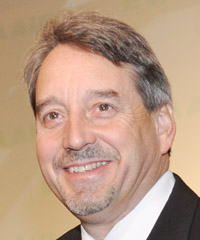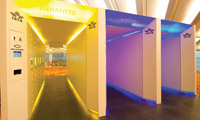Special Report: Security
The real cost of aviation security
Ever since the U.S. terrorist attacks of 9/11, the cost of improving security measures has been on the rise. Some experts say the real price to the aviation industry, airlines, airports and other players, has been seriously underestimated and that in coming years the cost is going to soar to even greater heights.
June 1st 2012
According to the International Air Transport Association (IATA) airlines pay out somewhere between $6 billion and $7 billion annually to meet their security requirements. What concerns Andrew Herdman, director general of the Association of Asia Pacific Airlines (AAPA) is that this figure hides another, far more expensive reality. Read More »
 |
| 'My estimate is that the cost of passenger security measures [across the industry] is probably about $20 billion a year' |
| Andrew Herdman Director General AAPA |
“My concern is we are not facing up to the real cost of aviation security measures because the costs are hidden inside operational costs for airlines and airports,” he said.
“It’s helpful to face up to the cost of what we are imposing on passengers and shippers overall. My estimate is that the cost of passenger security measures [across the industry] is probably about $20 billion a year - and that doesn’t include putting a value on the time that people spend standing in line to pass through security procedures.”
A new analysis, The Global Airport Security Market Assessment, released in April by research firm Frost & Sullivan, reported that airports alone last year spent $19.1 billion on security measures. The researcher expects this figure to rise to $45 billion annually by 2018.
If this is correct the industry in 2011 spent at least $25 billion on security and if the combined spend of airports, airlines and others is included, by 2018 the cost could reach around $60 billion. Much of that, one way or another, would be passed on to passengers.
Frost & Sullivan believes long-term growth in global passenger numbers ensures investment in airport infrastructure will continue to rise in the years ahead, with airports adopting increasingly sophisticated technology to meet their security needs.
And, it said, this would prove particularly the case in Asia-Pacific countries such as China and India “where more technologically advanced security equipment needs to be procured to ensure that airports meet stricter regulations and the highest security standards”.
Spending by the region’s airports on security is expected to reach up to $10 billion annually by 2015.
 |
| Checkpoint of the Future: could be seven to 10 years away |
While security costs continue to climb, Herdman believes it’s time for a new approach. Aviation is a very safe industry that continues to become safer, he said. Any safety initiatives have to pass a cost benefit analysis.
“That argument doesn’t apply to security. We don’t use the same methodology when looking at security so we don’t face up to the cost and we don’t try to estimate the benefits,” said Herdman.
“Overall, philosophically, we need to embrace some of the lessons we have learned from safety into security measures with an attempt at some sort of cost benefit analysis. That means facing up to the costs rather than becoming bogged down in arguing who is going to absorb them. Ultimately, of course, the costs will be borne by the travelling public and society at large.”
Herdman has another worry. “There is growing concern among all stakeholders as to the scalability of the existing security measures. If traffic is going to double in the next 15 years, are the current systems capable of handling that growth?” he said.
It’s a point being addressed by the wider global airline industry. IATA director general, Tony Tyler, said recently the introduction of more complex security procedures has resulted in a decline in hourly passenger throughput at security checkpoints from an average of 335 prior to 9/11 to 149 today.
“Security is a top priority that must not be compromised,” he said. “But everybody hopes for an early evolution from an airport checkpoint experience defined by queuing, unpacking, removing clothing, separating certain items and possibly invasive searches. The system works, but it is struggling to cope with today’s volumes.
“And when we add another 877 million passengers to the queues in a few years time, the experience is bound to deteriorate even further.”
Is the industry making any progress towards meeting the security cost and efficiency challenge? The answer, according to most analysts, is yes, although the major breakthroughs are some years away.
For example, IATA’s much publicized project to create a Checkpoint of the Future is underway. Early versions are being trialled. Using passenger data collected for immigration authorities to differentiate airport screening – travellers would walk through different archways depending on their assessed risk – and new technology to enable passengers to walk through checkpoints without stopping or unpacking, it already has support from Interpol, the European Commission, the U.S. Department of Homeland Security and the Chinese government.
Some 16 states have endorsed the concept. But the technology is not expected to be fully available for between seven and 10 years.
Herdman regards the Checkpoint of the Future as “experimental” and a way of thinking about how things can be done differently. “I’m not sure I buy the argument of having different archways and identifying people publicly as to how they are being categorized. We already have red and green lanes for customs,” he said.
“In the case of catching terrorists you don’t normally advertise that you have different levels of security. You apply that in the background.”
Herdman believes progress is being made, but security remains a complex challenge and standardization is difficult to achieve. “ICAO (International Civil Aviation Organization) provides the lead on this issue and aviation security is very good worldwide,” he said.
“That’s a reflection that ICAO publishes guidelines and standards that direct governments. But some governments are not content with that and impose additional levels of security, notably the Americans and Europeans.”
A higher level of inter-governmental co-operation on the security challenge has emerged in recent years. Herdman pointed to a security conference held in Kuala Lumpur in January aimed at promoting the implementation of an ICAO Declaration on Aviation Security. Similar gatherings have been held in New Delhi, Dakar in Senegal, Moscow, Venezuela and the Middle East, which will lead to a global conference at ICAO’s Montreal headquarters in Montréal in September.
Among delegates at the Kuala Lumpur conference was John S. Pistole, administrator of the U.S. Transportation Security Administration (TSA). Herdman said it was “recognition that we need a global approach that’s not just the sum total of national measures”.
Herdman told the conference: “Government agencies, airports, airlines, and service providers need to work closely together on policy development, as well as practical implementation measures, with the aim of achieving the right balance between effective security and efficient facilitation.
“Recognizing the need to avoid unnecessary duplication of effort arising from a patchwork of uncoordinated national measures, we need to work towards common standards and mutual recognition of respective national security regimes.”
Meanwhile, a long running dispute between the U.S. and Europe about air passenger data was finally resolved in April.
Members of the European Parliament had battled for more than five years to scale back agreements that allow the U.S. to access and store air passenger data. Europe called it an invasion of privacy that could lead to false arrests, but finally backed down and voted to allow the data to be provided.
The U.S. agreed to mask out passengers’ names and contact details after six months. The data will be kept for up to five years, after which it will move to a “dormant” database for another 10 years.
Progress is also being made in cargo security. In March, IATA announced its Secure Freight programme, launched in 2010 with a pilot programme at Kuala Lumpur, had gained further recognition from governments worldwide.
IATA and the Malaysia Civil Aviation Authority signed a Memorandum of Understanding (MoU) on expanding the pilot scheme. The UK Department of Transport (DoT) also agreed to endorse the Secure Freight principles. The first authority to officially endorse Secure Freight principles was the Australian Office of Transport Security, in 2011.
The Secure Freight programme works across the whole air cargo supply chain, helping to secure shipments upstream by ensuring that cargo has come from either a known consignor or regulated agent. The programme evaluates the strength of a nation’s aviation security infrastructure and works with the civil aviation authorities to ensure cargo is kept sterile until loaded. This also helps prevent bottlenecks at airports.
IATA’s Tyler has urged the industry to work together and in cooperation with governments on industry solutions for cargo security, or risk the imposition of regulatory solutions that may not fully understand the operational realities of global air cargo.
“The challenge is two-fold. We must continuously improve security to meet evolving threats. And we need to achieve this while maintaining the speed necessary to support global commerce,” he said.
Herdman said the key to cargo security was that it could not all be done at the airport with screening. “You have to make the whole supply chain secure. That means long before the shipment arrives at the airport you’ve got to look at manufacturers, freight forwarders and logistics companies.”
Herdman said there has to be some form of accreditation or certification of people in the supply chain. “We have the problem that these initiatives are nationally originating and yet air cargo is a global business. How do you get mutual recognition of those security regimes around the world? That’s taking some time,” he said.
Nevertheless, Herdman believes the system is working well. “One of the reasons people choose air cargo apart from the speed, even though it is expensive relative to other modes of transport, is that it is highly secure.”